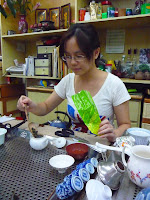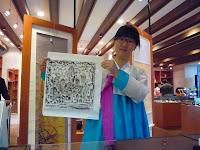
Whether you are a tea professional or simply a person who enjoys a good cup of tea, you can enhance your experience of drinking tea by following some basic tasting techniques.
As a professional tea cupper and blender, I am conscious of several components of everything I eat and drink.
First of all, paying attention to what you are doing and being in the moment is extremely important. It allows you to focus on fragrance, taste, texture and appearance. All of these add to your experience and enjoyment.
Let’s look at three parts of a tea tasting experience. We can take note of the dry leaf, the infused leaf and the infusion itself.
When analyzing the dry leaf we can look for colour, feel, appearance and fragrance of the leaf. Colours can range from pale yellow to green to deep, dark red. Tea can feel silky or rough to the touch. It can be twisted, short, long or broken. Does it smell floral, vegetative or musky?
The infused wet leaf will be a different experience as it has had water and heat applied to it. Noting the colour, feel and smell of the leaf after it has gone through chemical changes we find different properties than the above step. We can start to differentiate between types of tea, for example, white, green, oolong, black and pu-erh.
After analyzing the dry and wet leaf, your palette will be ready to taste the brewed tea infusion. Smell the tea leaving your mouth open slightly. This readies the taste buds in your mouth. Take a small amount of tea into your mouth and swish it gently around before swallowing. Pay attention to all areas of your mouth: the roof, all sides, your tongue and your throat. What are you experiencing? Bitterness, smoothness, sweetness and silkiness may be some terms to describe what you find. Take note. Continue by taking another small sip of tea and this time draw some air into your mouth and over the tea with a slurping sound. This will add air to the tea and magnify what you taste. Pay attention to colour, fragrance, taste and mouth feel afterwards. You can then make a decision on whether you like this tea.
Keeping notes on your experiences of tea can be valuable as you build a selection to refer to. I suggest tasting as many varieties of tea as you can to build a point of reference for comparison. Tasting teas from different categories and countries of origin for those types will widen your experience.
Most important though is to enjoy every tea for its uniqueness.
























